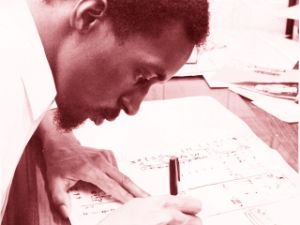Live Performances | Julius Eastman
Let Sonorities Ring – Julius Eastman
Live Performances

Julius Eastman © Donald W. Burkhardt
From 17th to 26th of March, the space of SAVVY Contemporary will become a documentation centre dedicated to the oeuvre of Julius Eastman (1940–1990). Archival material including original recordings, video footage and scores will be made available to the public. Live Acts will contribute beats and sounds to the program, widening and imaginatively deepening the perspective on Eastman’s work. “Let Sonorities Ring” is the first chapter in a one-year research project focusing on the life and works of the Afro-American composer, vocalist and performer that will culminate in an exhibition and a “Julius Eastman Festschrift”.
About the live performances
“For a political artist, which I feel is really any artist who makes a point of being aware of the extensions of control within themselves and their practice, the gesture of resistance has to be put into question again and again, most definitely beyond the easily recuperable referential relativisms that pervade our postmodern moment…”.
Sam Shalaby, Liner Notes, in “Dreams and Music: Hassan Khan”, Revolver Press, 2016
With these words composer and musician Sam Shalabi introduces the musical work of Hassan Khan, but it is precisely this political and aural liminal space that all artists in this project inhabit. Artists and musicians who speak or respond to Julius Eastman’s practice, with new or old works, by focusing on his music, vocal experiments and performances more than on his biographical story. Khan’s practice spans the visual arts, writing and music, in a tentacular approach where every aspect informs the other. In the music scene through different guises since the early 90s, and a musical autodidact, Khan’s electro-acoustic compositions and live performances defy classifications and have been extremely diverse in structure, in references and in narrative. In some of his pieces, pop culture and the history of music and popular movements in Egypt, the city of Cairo and its soundscapes, can certainly be considered important influences. In one of his latest pieces for example, titled “Taraban” (2014), Khan takes two early twentieth century Egyptian songs by Youssef El Manialawy as a point of departure, working with classical Arabic melodic patterns and instruments such as the Oud, the Qanoun, and the Riqq, but completely reformulating their sounds. In the context of “Let Sonorities Ring – Julius Eastman” Khan will present “Live Ammunition! Music for Clapping, String Quartet and Live Electronics” (2013), a 40 minutes piece in which different layers of string quartets and clapping patterns are used as "instruments" to produce a musical horizon. One in which structure regulates the emotional engagement with the piece, one that attracts and distances the audience at different times. A piece that is interested in suspension, and a dramatic yet subtle dialogue between its contrasting parts as well as with the listening audience. This is how the artist himself loosely defines the work: “on the shores of a new ocean - there are no resolutions only undercurrents and potential”.
Also Jace Clayton moves between different contexts, working as an artist, a musician, a software designer and a DJ. Through his work as DJ/rupture, Clayton has travelled half of the world and has engaged in many different collaborations, ranging from Norah Jones to the Barcelona Symphony Orchestra, to low budget tours throughout South America. Clayton’s work, as in his own words, focuses on how “sound, memory, and public space interact, with an emphasis on low-income communities and the global South”. He has an interest in how sound creates social meaning and in how to manufacture new electronic devices for producing music that defy western conceptions of sound. Eastman’s work has been an important reference for Clayton, who produced one of the earliest pieces dedicated to his oeuvre: the “Julius Eastman Memorial Dinner”, a 70-minute performance piece for grand pianos, live electronics, and voice. For “Let Sonorities Ring – Julius Eastman” Clayton will present a new piece “ALLGEGENWART (OMNIPRESENCE document 1)”. OMNIPRESENCE is an upcoming choral composition by Clayton written in response to harsh night-time police lighting in his Harlem neighbourhood. Understanding the bright lights as a manifestation of institutional hostility towards blackness, the choir will sing to the outdoor surveillance lights, creating a space of contemplation that engages with the history of choral music as sacred praise to a higher power and simultaneously re-purposes the carceral infrastructure. For “ALLGEGENWART”, Berlin’s PHØNIX16 ensemble performs an excerpt from “OMNIPRESENCE” as a public concert, the recording of which Clayton will then rework into an hour-long radiophonic composition for voice and electronics.
Hassan Khan
Live Ammunition! Music for Clapping, String Quartet and Live Electronics (2013)
Jace Clayton
ALLGEGENWART (OMNIPRESENCE document 1) (2017) WP
Hassan Khan live electronics
PHØNIX16
Sirje Aleksandra Viise, Eva Zwedberg, Vanessa Chartrand-Rodrigue, Michael Taylor, Magnús Hallur Jónsson, Oskar Koziołek Goetz
Nick Hallett choir director of ALLGEGENWART
Conceived by Bonaventure Soh Bejeng Ndikung & Berno Odo Polzer
Co-curated by Antonia Alampi, Elena Agudi, Bonaventure Soh Bejeng Ndikung & Berno Odo Polzer
Research curator Lynhan Balatbat Helbock
Hassan Khan’s contribution has been supported by ZK/U – Centre for Art and Urbanism
All video credits: S.E.M. Ensemble and Third Eye/CCA Archive, Glasgow
For the research material we would like to thank Mary Jane Leach, the University at Buffalo Music Library and Dustin Hurt for their invaluable support.
Produced by SAVVY Contemporary and MaerzMusik – Festival for Time Issues